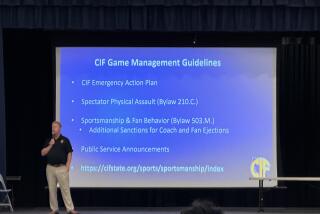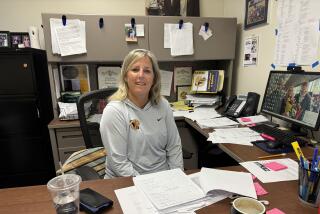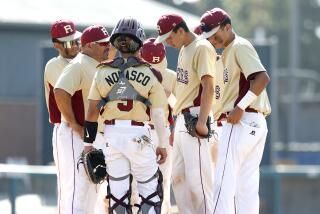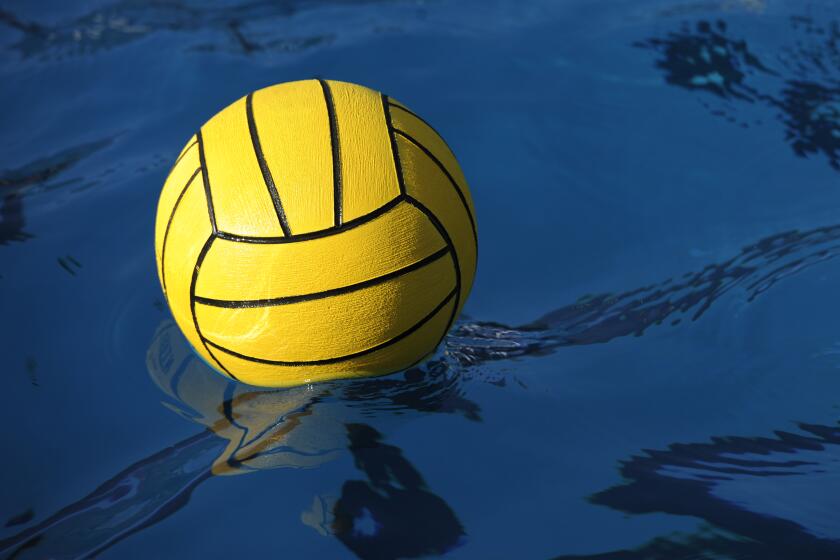Pasadena High Cuts Sports Practice Time
PASADENA — To Pasadena High School Principal Judy Codding, it’s a matter of scheduling. To sports boosters, it’s the beginning of the end for the school’s proud athletic tradition.
Next semester, Codding will no longer change the schedules of student athletes to allow them to work out together during the school day.
Some parents and coaches say Codding has upset the delicate balance of emphasis between academics and sports. They also say she has just condemned the school’s sports program to mediocrity, since other teams in the six-school Pacific League will continue to practice during last period.
But Codding told about 70 parents, coaches and students who gathered in the school cafeteria Monday night that the students need continuity in their academic schedules, even if it means not allowing athletes to practice together during seventh period.
So far this year, such continuity has been lacking, she said, primarily because 250 more students than expected enrolled. By the time the district hired new teachers, more than 1,600 of the school’s 2,200 students had their schedules changed, some two or three times.
“We saw an increase in ditching, more students being absent, an increase in discipline problems because there was no consistency,” Codding said.
Current schedules have been set for only three weeks, Codding said, and she doesn’t want to disrupt them next semester for team practice. Students wishing to change electives will have to find classes that meet at the same time as their current electives.
Codding also said that state regulations permit last-period team classes only for conditioning, and that students still can exercise in regular physical education classes.
Moreover, she said, it is hard to justify why some high-profile sports, such as football, got the class period, while others, such as women’s tennis, did not.
The explanation didn’t satisfy some members of the sports booster club, which sells food concessions at games, donates small gifts to coaches and raises about $12,000 a year for the school’s athletic program.
High school should be more than a mental assembly line, said booster club President Warren Brown, a psychology professor at Fuller Theological Seminary in Pasadena.
Brown’s wife, Janet, agreed. “What kept my kids here, and why I permitted them to stay here, was that balance,” she said. “I didn’t have to worry about drugs with my kids because they had their team, their friends.”
Last-period practice was important, she said, because “there’s team unity built, a rapport with the coach developed. They work on specific skills” not emphasized in a regular physical education class.
Other parents were concerned that later starting times would result in games lasting after dark.
Assistant Athletic Director Gary Griffiths said injuries might result from students lacking the opportunity for sport-specific conditioning. State regulations limit how soon a team can begin to practice after school before a season starts. “It’s going to be harder to get a pitcher prepared to throw without risking hurting his arm,” he said.
Sophomore Duane Bailey, who plays junior varsity football and basketball, said athletes “need all the extra practice we can get. I think we should keep the period.”
One school official, who asked not to be named, viewed the new policy as foreshadowing the downfall of strong high school athletic programs, which for some students supply crucial motivation.
Bailey, 16, said he knows students who stuck with school work just to play sports.
This past semester, 15 of 18 borderline students survived academic probation and remained eligible to play football, according to the school.
On the other hand, about 1,500 of the school’s 2,200 students are ineligible to compete because their grade-point average is below C, Codding said.
Codding, who played varsity tennis in high school, said she would like to improve the athletic program by helping more students improve their grades and qualify for sports.
The school policy, so far, applies only to the spring semester. But the Pasadena Unified School District will discuss ending last-period athletics districtwide to save money and meet new state physical education requirements, said John Porter, director of secondary education for the district.
Codding said any money saved should go back to the athletic program for coaches’ salaries and new equipment.
Coaches and parents said they doubt that the money saved by eliminating team classes would be returned to the athletic department.
“Her support for the athletic program is not there to the extent of someone who understands Southern California sports,” Janet Brown said of Codding, a Harvard-educated native of Florida. “It may be an East Coast-West Coast culture thing.”
Codding defended her priorities. “All extracurricular programs are an integral part of the total school program,” she said. “But what drives the schools has to be the curriculum and students’ performance in that.”
More to Read
Get our high school sports newsletter
Prep Rally is devoted to the SoCal high school sports experience, bringing you scores, stories and a behind-the-scenes look at what makes prep sports so popular.
You may occasionally receive promotional content from the Los Angeles Times.







